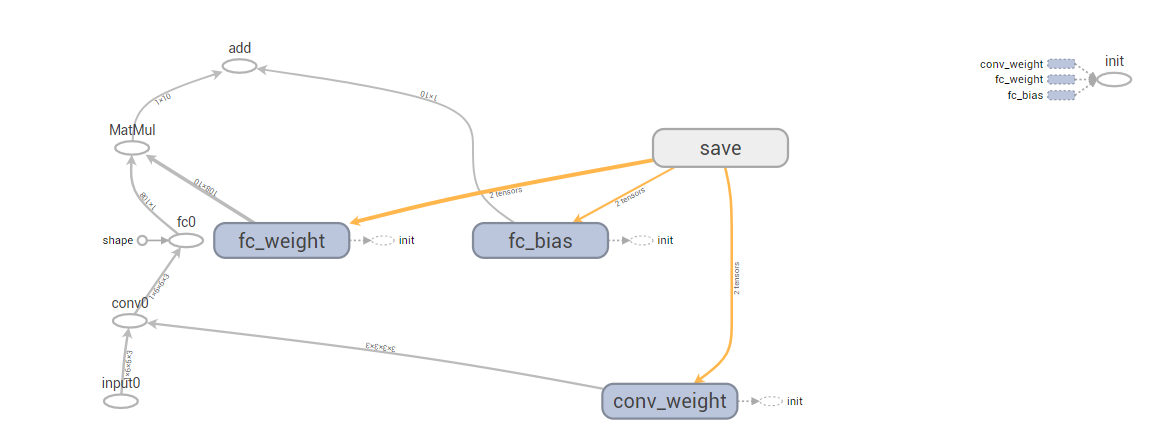tensorflow 模型前向传播 保存ckpt tensorbard查看 ckpt转pb pb 转snpe dlc 实例
参考:
TensorFlow 自定义模型导出:将 .ckpt 格式转化为 .pb 格式
TensorFlow 模型保存与恢复
tensorflow 模型前向传播 保存ckpt tensorbard查看 ckpt转pb pb 转snpe dlc 实例
log文件


输入节点 图像高度 图像宽度 图像通道数
input0 6,6,3
输出节点
--out_node add
snpe-tensorflow-to-dlc --graph ./simple_snpe_log/model200.pb -i input0 6,6,3 --out_node add
#coding:utf-8
#http://blog.csdn.net/zhuiqiuk/article/details/53376283
#http://blog.csdn.net/gan_player/article/details/77586489
from __future__ import absolute_import, unicode_literals
import tensorflow as tf
import shutil
import os.path
from tensorflow.python.framework import graph_util
import mxnet as mx
import numpy as np
import random
import cv2
from time import sleep
from easydict import EasyDict as edict
import logging
import math
import tensorflow as tf
import numpy as np def FullyConnected(input, fc_weight, fc_bias, name):
fc = tf.matmul(input, fc_weight) + fc_bias
return fc def inference(body, name_class,outchannel):
wkernel = 3
inchannel = body.get_shape()[3].value
conv_weight = np.arange(wkernel * wkernel * inchannel * outchannel,dtype=np.float32).reshape((outchannel,inchannel,wkernel,wkernel))
conv_weight = conv_weight / (outchannel*inchannel*wkernel*wkernel)
print("conv_weight ", conv_weight)
conv_weight = conv_weight.transpose(2,3,1,0)
conv_weight = tf.Variable(conv_weight, dtype=np.float32, name = "conv_weight")
body = tf.nn.conv2d(body, conv_weight, strides=[1, 1, 1, 1], padding='SAME', name = "conv0")
conv = body
conv_shape = body.get_shape()
dim = conv_shape[1].value * conv_shape[2].value * conv_shape[3].value
body = tf.reshape(body, [1, dim], name = "fc0")
fc_weight = np.ones((dim, name_class))
fc_bias = np.zeros((1, name_class))
fc_weight = tf.Variable(fc_weight, dtype=np.float32, name="fc_weight")
fc_bias = tf.Variable(fc_bias, dtype=np.float32, name="fc_bias")
# tf.constant(100,dtype=np.float32, shape=(body.get_shape()[1] * body.get_shape()[2] * body.get_shape()[3], name_class])
# fc_bias = tf.constant(10, dtype=np.float32, shape=(1, name_class])
body = FullyConnected(body, fc_weight, fc_bias, "fc0")
return conv, body export_dir = "simple_snpe_log"
def saveckpt():
height = 6
width = 6
inchannel = 3
outchannel = 3
graph = tf.get_default_graph()
with tf.Graph().as_default():
input_image = tf.placeholder("float", [1, height, width, inchannel], name = "input0")
conv, logdit = inference(input_image,10,outchannel)
init = tf.global_variables_initializer()
with tf.Session() as sess:
sess.run(init)
img = np.arange(height * width * inchannel, dtype=np.float32).reshape((1,inchannel,height,width)) \
/ (1 * inchannel * height * width) * 255.0 - 127.5
print("img",img)
img = img.transpose(0,2,3,1)
import time
since = time.time()
fc = sess.run(logdit,{input_image:img})
conv = sess.run(conv, {input_image: img})
time_elapsed = time.time() - since
print("tf inference time ", str(time_elapsed))
print("conv", conv.transpose(0, 2, 3, 1))
print("fc", fc)
#np.savetxt("tfconv.txt",fc)
#print( "fc", fc.transpose(0,3,2,1))
#np.savetxt("tfrelu.txt",fc.transpose(0,3,2,1)[0][0]) # #save ckpt
export_dir = "simple_snpe_log"
saver = tf.train.Saver()
step = 200
# if os.path.exists(export_dir):
# os.system("rm -rf " + export_dir)
if not os.path.isdir(export_dir): # Create the log directory if it doesn't exist
os.makedirs(export_dir) checkpoint_file = os.path.join(export_dir, 'model.ckpt')
saver.save(sess, checkpoint_file, global_step=step) def LoadModelToTensorBoard():
graph = tf.get_default_graph()
checkpoint_file = os.path.join(export_dir, 'model.ckpt-200.meta')
saver = tf.train.import_meta_graph(checkpoint_file)
print(saver)
summary_write = tf.summary.FileWriter(export_dir , graph)
print(summary_write) def ckptToPb():
checkpoint_file = os.path.join(export_dir, 'model.ckpt-200.meta')
ckpt = tf.train.get_checkpoint_state(export_dir)
print("model ", ckpt.model_checkpoint_path)
saver = tf.train.import_meta_graph(ckpt.model_checkpoint_path +'.meta')
graph = tf.get_default_graph()
with tf.Session() as sess:
saver.restore(sess,ckpt.model_checkpoint_path)
height = 6
width = 6
input_image = tf.get_default_graph().get_tensor_by_name("input0:0")
fc0_output = tf.get_default_graph().get_tensor_by_name("add:0")
sess.run(tf.global_variables_initializer())
output_graph_def = tf.graph_util.convert_variables_to_constants(
sess, graph.as_graph_def(), ['add'])
model_name = os.path.join(export_dir, 'model200.pb')
with tf.gfile.GFile(model_name, "wb") as f:
f.write(output_graph_def.SerializeToString()) def PbTest():
with tf.Graph().as_default():
output_graph_def = tf.GraphDef()
output_graph_path = os.path.join(export_dir,'model200.pb')
with open(output_graph_path, "rb") as f:
output_graph_def.ParseFromString(f.read())
tf.import_graph_def(output_graph_def, name="") with tf.Session() as sess:
tf.initialize_all_variables().run()
height = 6
width = 6
inchannel = 3
outchannel = 3
input_image = tf.get_default_graph().get_tensor_by_name("input0:0")
fc0_output = tf.get_default_graph().get_tensor_by_name("add:0")
conv = tf.get_default_graph().get_tensor_by_name("conv0:0") img = np.arange(height * width * inchannel, dtype=np.float32).reshape((1,inchannel,height,width)) \
/ (1 * inchannel * height * width) * 255.0 - 127.5
print("img",img)
img = img.transpose(0,2,3,1)
import time
since = time.time()
fc0_output = sess.run(fc0_output,{input_image:img})
conv = sess.run(conv, {input_image: img})
time_elapsed = time.time() - since
print("tf inference time ", str(time_elapsed))
print("conv", conv.transpose(0, 2, 3, 1))
print("fc0_output", fc0_output) if __name__ == '__main__': saveckpt() #1
LoadModelToTensorBoard()#2
ckptToPb()#3
PbTest()#
tensorflow 模型前向传播 保存ckpt tensorbard查看 ckpt转pb pb 转snpe dlc 实例的更多相关文章
- Tensorflow模型加载与保存、Tensorboard简单使用
先上代码: from __future__ import absolute_import from __future__ import division from __future__ import ...
- TensorFlow模型加载与保存
我们经常遇到训练时间很长,使用起来就是Weight和Bias.那么如何将训练和测试分开操作呢? TF给出了模型的加载与保存操作,看了网上都是很简单的使用了一下,这里给出一个神经网络的小程序去测试. 本 ...
- 利用tensorflow实现前向传播
import tensorflow as tf w1 = tf.Variable(tf.random_normal((2, 3), stddev=1, seed=1))w2 = tf.Variable ...
- Tensorflow笔记——神经网络图像识别(一)前反向传播,神经网络八股
第一讲:人工智能概述 第三讲:Tensorflow框架 前向传播: 反向传播: 总的代码: #coding:utf-8 #1.导入模块,生成模拟数据集 import t ...
- tensorflow模型的保存与恢复,以及ckpt到pb的转化
转自 https://www.cnblogs.com/zerotoinfinity/p/10242849.html 一.模型的保存 使用tensorflow训练模型的过程中,需要适时对模型进行保存,以 ...
- tensorflow模型持久化保存和加载
模型文件的保存 tensorflow将模型保持到本地会生成4个文件: meta文件:保存了网络的图结构,包含变量.op.集合等信息 ckpt文件: 二进制文件,保存了网络中所有权重.偏置等变量数值,分 ...
- Tensorflow模型变量保存
Tensorflow:模型变量保存 觉得有用的话,欢迎一起讨论相互学习~Follow Me 参考文献Tensorflow实战Google深度学习框架 实验平台: Tensorflow1.4.0 pyt ...
- tensorflow模型持久化保存和加载--深度学习-神经网络
模型文件的保存 tensorflow将模型保持到本地会生成4个文件: meta文件:保存了网络的图结构,包含变量.op.集合等信息 ckpt文件: 二进制文件,保存了网络中所有权重.偏置等变量数值,分 ...
- 超详细的Tensorflow模型的保存和加载(理论与实战详解)
1.Tensorflow的模型到底是什么样的? Tensorflow模型主要包含网络的设计(图)和训练好的各参数的值等.所以,Tensorflow模型有两个主要的文件: a) Meta graph: ...
随机推荐
- Vivado+FPGA:如何使用Debug Cores(ILA)在线调试(烧录到flash里可以直接启动)
在Vivado下在线调试是利用ILA进行的,Xilinx官方给出了一个视频,演示了如何使用Vivado的debug cores,下面我根据这个官方视频的截图的来演示一下: 官方的视频使用的软件版本为2 ...
- DevExpress GridControl List绑定方式下新增行的方法
List<Person> gridDataList = new List<Person>(); //此处是数据源 List集合 BindingList<Person> ...
- openssl之EVP系列之13---EVP_Open系列函数介绍
openssl之EVP系列之13---EVP_Open系列函数介绍 ---依据openssl doc/crypto/EVP_OpenInit.pod翻译和自己的理解写成 (作者:Dra ...
- calcite 理论
https://blog.csdn.net/yunlong34574/article/details/46375733 https://cloud.tencent.com/developer/arti ...
- 递归分治算法之二维数组二分查找(Java版本)
[java] /** * 递归分治算法学习之二维二分查找 * @author Sking 问题描述: 存在一个二维数组T[m][n],每一行元素从左到右递增, 每一列元素从上到下递增,现在需要查找元素 ...
- DIOCP开源项目-数据库连接池的使用<多帐套数据库>
很久没有写DIOCP的Demo了,主要公司的事情太繁琐,工作之余都不想动了,之前承若的群里面朋友们的DEMO,昨天晚上恶补了一下,把对数据库连接池的操作加入到了Demo中,大家可以通过SVN下载到最新 ...
- html5的拖拽dragAPI(如果看了API不懂,看看那三个案例就会恍然大悟)
1.拖拽和释放定义: 拖拽:Drag; 释放:Drop; 2.源对象和目标对象: 3.相关API: ondragstart:源对象开始被拖动 ondrag:源对象被拖动的过程中 ondragend:源 ...
- 多媒体文件格式之TS
[时间:2016-07] [状态:Open] TS流是MPEG-2标准中定义一种用于直播的码流结构,具有很好的容错能力.所有跟TS相关的标准可以从ISO/IEC_13818-1中找到. 通常TS流的后 ...
- java连接https时禁用证书验证.
import java.io.File; import java.security.cert.CertificateException; import java.util.List; import j ...
- Android开发(三)——Android布局中实现圆角边框
设置corners_bg.xml(设置边框圆角可以在drawable-mdpi目录里定义一个xml): <?xml version="1.0" encoding=" ...
